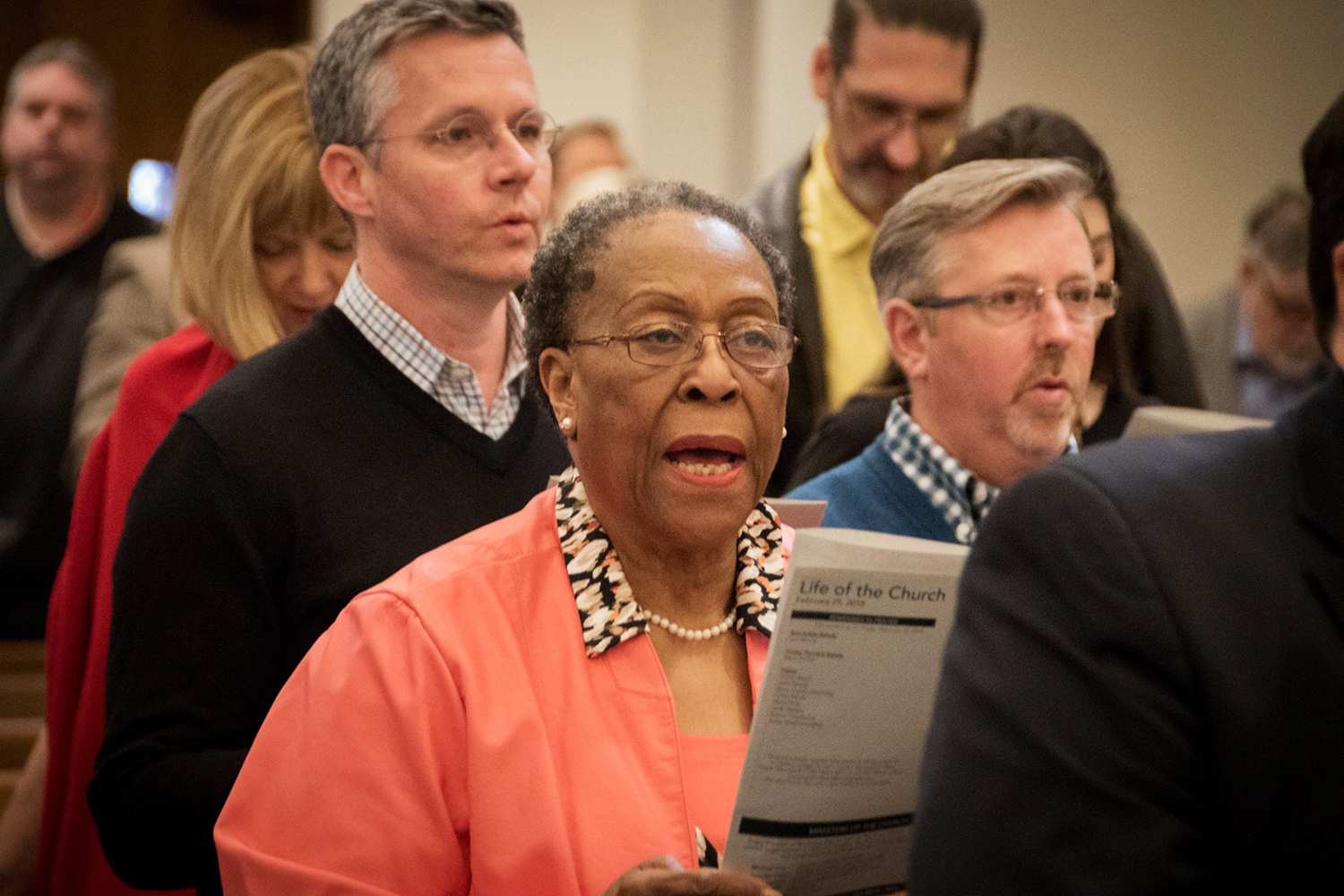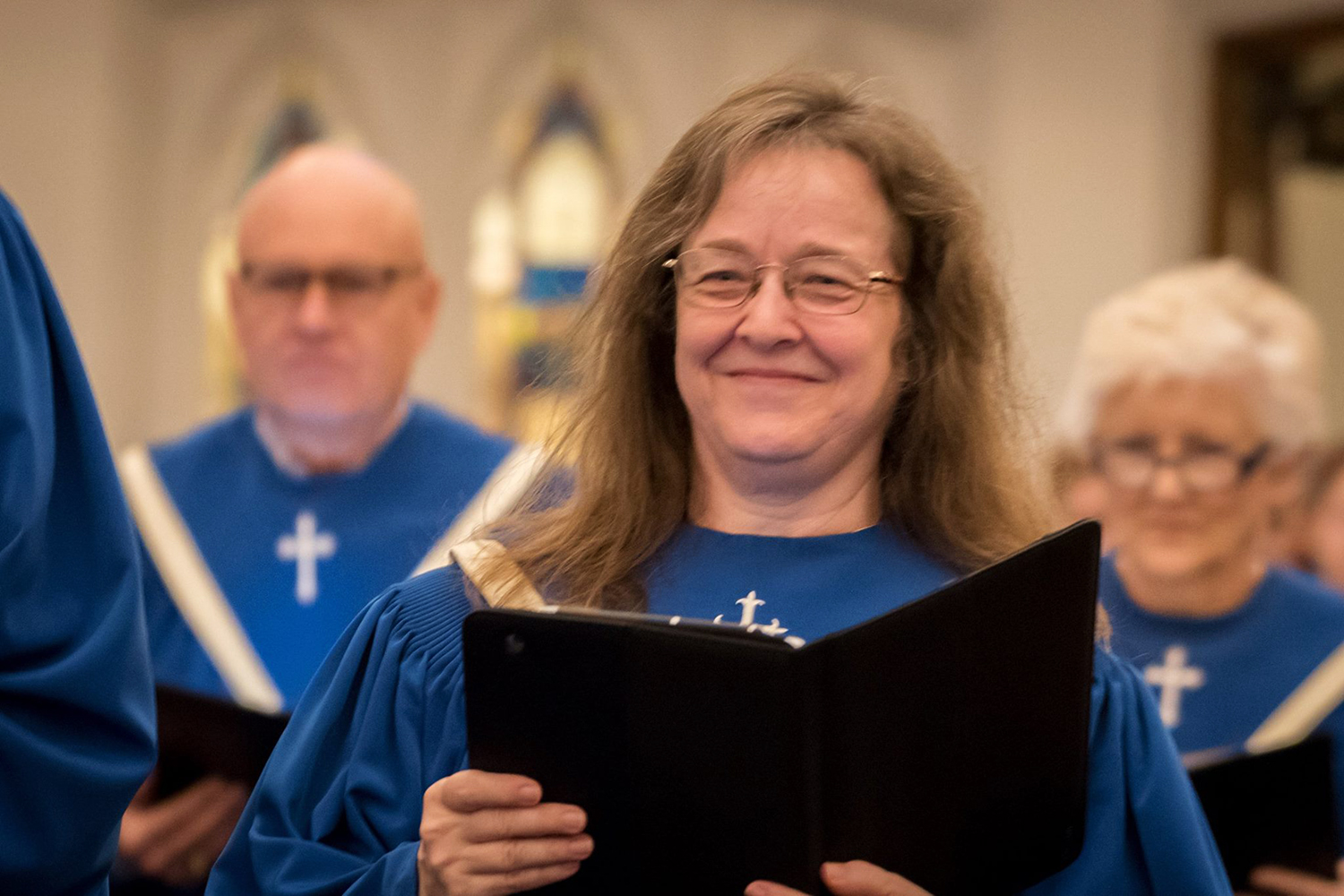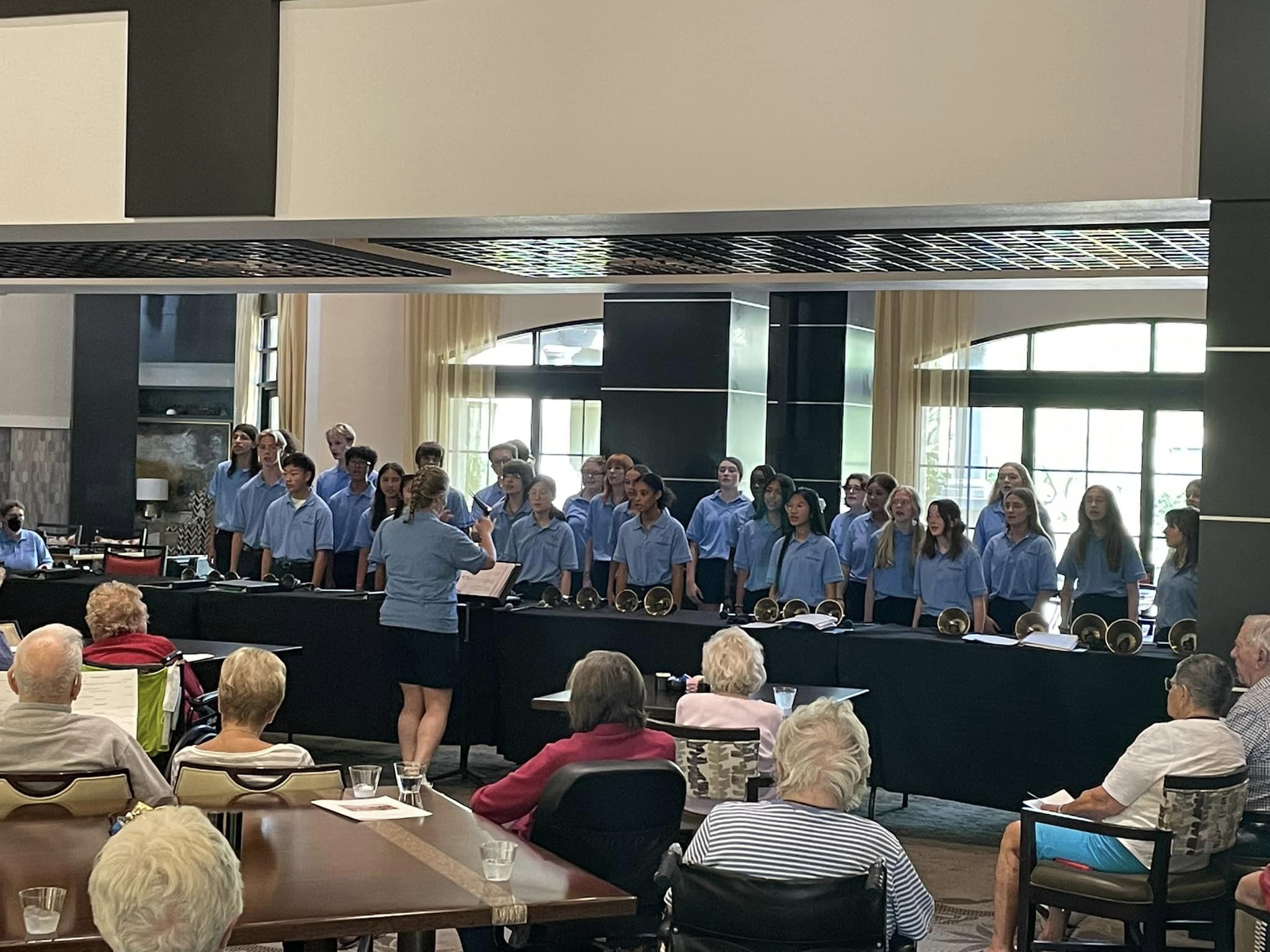Music and Worship
Music is an integral part of the Broadway experience, from the inspiring voices of our Chancel Choir to the stirring notes of the Cliburn Pipe Organ.
Chancel Choir & Handbells
Broadway’s Chancel Choir has over 70 members and sings for Sunday morning services. They also sing for extra services such as Ash Wednesday, Maundy Thursday, and Good Friday. This choir also leads the annual Messiah Sing. Rehearsals are Wednesdays at 7:00 pm and Sundays at 9:00 and 10:30 am.
We offer an adult handbell choir as well. They participate a few times a year in worship. This group is made up of a mixture of musical abilities. They rehearse Wednesday evenings at 6:00 pm. Contact Tiffany McClain for more information
Children & Youth Music Program
- Chapel Choir & Handbells (Grades 7-12)
- Concord Choir & Handbells (Grades 5 & 6)
- Children’s Choir (Grades 1-4)
- Children’s Handbells (Grades 3-4)
- Choirchimes (Grades 1-2)
- Preschool Children (3 years old-Kindergarten)
See Preschool, Children, Club 56, & Youth pages for more information about the choirs and rehearsal times.
Contact Emily Davis for more information about children and youth ensembles.
Messiah Sing
This annual event begins the Advent season with excerpts of Handel’s Messiah. Since 1980, this concert offers you the opportunity to sing along with the choir and orchestra. Soloists, the Chancel Choir, and orchestra provide the wonderful music in this advent celebration for the community.
An Advent Festival
This morning worship service celebrates the joyful music of the season. The Chancel Choir is joined by The Orchestra at Broadway.
Lessons and Carols
The Christmas Eve service follows the tradition of the Festival of Nine Lessons and Carols established by King’s College, Cambridge University. A brass ensemble accompanies the Chancel Choir and congregation.
Holy Week
On Monday, Tuesday, and Wednesday of Holy Week, we offer 30-minute noontime Lenten recitals. These recitals are designed to be reflective to focus on the life of Christ.
The Broadway Series
Throughout the year, we feature musicians and vocalists from Fort Worth and around the world in special worship services, recitals, and concerts.
Click here to join The Broadway Series contact list and stay informed on upcoming events.
The Rildia Bee O’Bryan Cliburn Organ – Opus 3750
Rildia Bee O’Bryan Cliburn and her son, world renowned Van Cliburn, were members of Broadway for many years and gave great support to the organ project.
Since its founding in 1882, Broadway Baptist Church’s inspiring music ministry has become an integral part of the church’s life. The Rildia Bee O’Bryan Cliburn Organ ensures that this rich tradition will continue.
Designed for use in worship, organ solo concerts, and symphonic concerts, the organ stands among the finest pipe organs in the world.
The Cliburn Organ makes a powerful statement about worship, the first priority of the church. In its most profound role as an aid to worship, the organ helps us to become more receptive to God. It literally helps us to explore the mysteries of God by unlocking our hearts. Sounds of the organ have the capacity to set the mood for worship and to prepare us for new and life-changing encounters with God. Exceptional in size and design, the organ has 10,615 pipes and 191 ranks.
Organ History & Specifications
The Cliburn Organ was handcrafted by Casavant Frères Limitée, St. Hyacinthe, Quebec, Canada. Established in 1879, Casavant is one of the significant builders of fine pipe organs in North America.
The organ is the largest that Casavant has built, and it is the largest organ in Texas. It also is the largest organ of French aesthetics in the world, reflecting the basic design concept of the 18th and 19th century French organ builders.
Designed for use in worship, organ solo concerts, and symphonic concerts, the organ stands among the finest pipe organs in the world. Its sound is full, warm, vital, and vibrant in color.
Exceptional in size and design, the Cliburn Organ has 10,615 pipes, 191 ranks, 129 independent stops and 11 divisions. The front portion of the instrument in the chancel area consists of 8,859 pipes, 160 ranks and 105 independent stops. The antiphonal organ in the rear gallery consists of 1,756 pipes, 31 ranks, and 24 independent stops.
The Cliburn Organ’s pipes, two consoles, and oak cases were crafted to fit the grand proportions of the sanctuary’s modified Gothic architecture. With a reverberation time of over five seconds, the sanctuary is a near perfect acoustical environment for the organ.
Two unique features of the organ are the horizontal trumpets in the front and back of the sanctuary and the addition of a Bombarde division specifically designed to play with orchestral forces.
Opus 3750 is an electro-pneumatic instrument, a type of organ Casavant began making in 1904. When an organist plays a note, electrical circuitry carries the impulse to open a valve, thus letting air into the pipe, as opposed to mechanical action (tracker) instruments in which the keys are attached by mechanical linkage to valves admitting air into the pipes.
The electro-pneumatic instrument was chosen because of the placement of the instrument in two areas of the sanctuary. This type of instrument also allows the front console to be moved to several locations for a variety of programs. Any combination of the 10,615 pipes is playable from either one or both of the five-manual (keyboard) consoles located at each end of the sanctuary.
Unlike most large organs that are built and installed in stages over many years, the Cliburn Organ was designed as a complete instrument. It was built and installed over a two-year period.
Casavant’s skilled artisans painstakingly made by hand and assembled both the chancel and antiphonal organs at their shop in St. Hyacinthe, Quebec. They used the most beautiful woods to build the Cliburn Organ – red oak for the consoles and cases; maples for the swell boxes and pedals; yellow poplar for the wooden pipes, chests and reservoirs; and rosewood and ebony for the keys. Tin and zinc alloys were used to make the metal pipes.
Construction of the antiphonal organ began in February 1994. Physical installation was completed in February 1995, and the tonal finishers completed voicing the instrument in April 1995. It was first played on Easter Sunday, April 16, 1995.
Installation of the chancel organ began in early February 1996 and was completed the first week of May 1996. The tonal finishers arrived in May and completed voicing the chancel instrument in September 1996. The entire organ was first played on Friday, October 11, 1996.
Specifications
| Divisions | Stops | Ranks | Pipes |
| Grand Orgue | 17 | 32 | 1,770 |
| Récit | 19 | 28 | 1,732 |
| Positif | 21 | 26 | 1,598 |
| Choeur | 14 | 19 | 1,152 |
| Solo | 13 | 14 | 854 |
| Bombarde | 6 | 18 | 858 |
| Chamade | 2 | 3 | 171 |
| Pédale | 13 | 20 | 724 |
| Antiphonal Grand Orgue | 10 | 4 | 866 |
| Antiphonal Récit | 10 | 13 | 750 |
| Antiphonal Pédal | 4 | 4 | 140 |
| —— | —— | —— | |
| Total | 129 | 191 | 10,615 |
Grande Orgue (Great)
The Grand Orgue or Great is the primary manual division containing the instrument’s most important foundation stops. On the Cliburn Organ this chorus of diapasons is based upon sixteen-foot or sub-unison pitch. All of the appropriate stops of the series, including mutations and mixtures, are located in the casework on the south chancel wall. This division also features distinctive flute colors and a chorus of reed stops.
Récit (Swell)
The Récit or Swell, located behind the Grand Orgue, is the largest of four expressive divisions. Its pipes are enclosed behind louvers which can be opened and closed by the organist to control the volume of its stops. The voices of the division are especially suitable for accompaniment and range from the very soft “Voix angeliques” to a full reed chorus based upon the Contra trombone 32′. Another unique feature of the large division is the inclusion of harmonic flute stops at unison and non-unison pitch levels.
Positif
The pipes of the Positif are found in the casework across the chancel from the Grand Orgue. This unenclosed division had a complete principal chorus based upon eight-foot pitch which, along with its more transparent character, functions as a secondary chorus to the Grand Orgue. The Positif contains all of the unison and non-unison pitches of the natural harmonic series. Such a rich pallet gives the organist almost endless possibilities for creating unusual and colorful sounds.
Choeur
The Choeur, or Choir organ is an expressive division found just behind the Positif. Its discreetly scaled and delicately voiced stops are useful in many roles including the accompaniment of solo voices and choirs.
Solo
The Solo is an expressive division located to the left of the Invitation Window. It includes harmonic flutes at 8′ and 4′ pitch, string and reed voices including English horns, French horn, orchestral oboe, bass clarinet and tuba.
Bombarde
The Bombarde is a division based upon French practice which includes a brilliant reed chorus and powerful cornets. The division’s diapason chorus uses slotted pipes to impart a distinctly different tone from the other principal stops in the organ.
Chamade
The polished copper horizontal trumpets are striking, visual features of both the main and antiphonal organs. Comparable to herald trumpets, they can be used in both solo and ensemble roles to provide a brilliant effect.
Pédale
This division contains the lowest bass pitches and therefore the largest and longest individual pipes including the 32′ principals in the two cases at the front of the nave. The division also has stops at the higher pitch levels and solo voices for playing melodic lines with the feet. The pedal organ is found behind the Gothic grillwork to the north of the Invitation window.
Antiphonal Grand Orgue
This is the Antiphonal organ’s equivalent to the chancel instrument’s division of the same name, but somewhat smaller in scope and design. It is located to the left and right of the Great Commission window.
Antiphonal Récit
The gallery organ’s expressive division speaks through the Gothic grillwork to the left of the Great Commission window.
Antiphonal Pédale
The Antiphonal Pedale stops are found both to the left and right of the Great Commission window and in the chamber on the right just beyond the gallery console.




